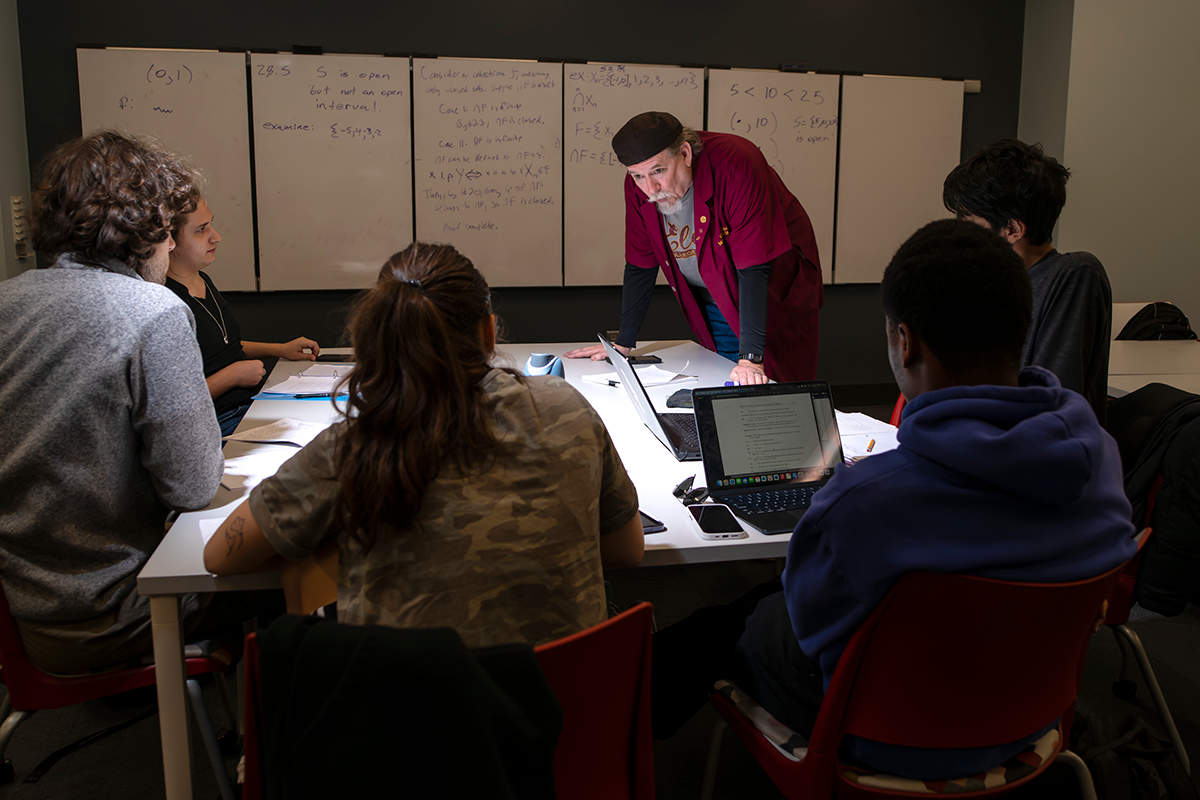Professor Todd Lee examines the role of math in democratic processes.
Math is often applied to facets of everyday life — cooking, shopping, budgeting, time management. But people rarely consider practical math uses when they think about elections and democracy.
Professor Todd Lee in Elon’s Department of Mathematics and Statistics studies the influential role math plays in shaping democratic processes. He has explored a multitude of mathematical questions in his 30 years of teaching at Elon, often driven by his students’ interests.
Lee’s journey into the intersection of math and democracy was sparked by an NPR broadcast he heard about a decade ago. The segment featured a Duke University team discussing its use of statistical analysis to detect unusually drawn electoral districts that revealed potential gerrymandering, the practice of drawing electoral districts to give one political party an unfair advantage.
“I was enthralled,” Lee says. “I started doing some studying myself, and I had a student at the time who was interested. I’ve done a lot of work with students on sports ranking, and ranking things is a fundamental part of voting. Whoever’s ranked number one gets to have the position. So it was a natural move for me to begin exploring the role of mathematics in voting systems.”
Inspired by Duke’s research, Lee began exploring political districting and election fairness in collaboration with his students, incorporating these themes into his undergraduate research and courses.
Lee says mathematics can detect gerrymandering by using statistical analysis to assess how many districts lean heavily toward one political party versus how many are competitive. Ideally, districts should be closely contested to prevent political extremes.
Expanding on this research, Lee worked with Lumen Scholar Amy Moore ’22 and Honors student Eli Bier ’24 on the random district generation problem. Using software such as Python and Mathematica, they explored their own algorithms on massive census and geographics data sets to create and analyze numerous districting maps, identifying unusual or unfair districting patterns.
This mathematical analysis of gerrymandering highlights one of several critical flaws in the U.S. electoral system and opens the door to exploring how other democratic nations approach voting and representation differently. In his global Core Curriculum courses that explore themes of math and democracy, Lee and his students analyze how districting and voting systems differ in other democratic countries.
Systems such as ranked-choice voting and proportional representation promote broader representation and political diversity, reducing the
likelihood of one party dominating
disproportionately. Compared to these systems, the U.S. model allows gerrymandering to silence minority viewpoints and distort political power.
“It was very eye-opening because I didn’t realize that last piece of how other democratic countries handle things like districting and voting,” Lee says. “They use different voting methods, and almost all of them use different districting methods than we do.”
Examining countries such as England, Germany, Japan, India, South Korea and New Zealand, Lee discovered that most democracies do not use the same winner-takes-all system as the United
States. Instead, many use dual methods for choosing representatives, ensuring that minority parties still have representation. For example, many democracies use ranked-choice voting, in which voters rank candidates by preference.
“It’s very rare to find democratic countries that use plurality-takes-all where whoever gets the most votes, even if it’s not a majority, wins everything,” Lee says.
Systems such as ranked-choice voting and proportional representation promote broader representation and political diversity, reducing the likelihood of one party dominating disproportionately. Compared to these systems, the U.S. model allows gerrymandering to silence minority viewpoints and distort political power.
For Lee, understanding how other democracies structure their electoral systems provides valuable insight into addressing flaws in the U.S. system. This exploration also ties into four key mathematical concepts in voting systems: apportionment, districting, voting methods and the power index of voting.
“Apportionment just means, how many representatives in the U.S. government, in the U.S. Congress, does North Carolina get?” Lee explains.
Districting and voting methods relate to how electoral boundaries are drawn and how voting systems — such as ranked ballots or popular votes — determine outcomes. The power index measures the mathematical influence within a voting body, highlighting how certain voters or groups can hold disproportionate power.
“Power index of voting goes on in any kind of situation where you have a group of people who vote and the majority wins or two-thirds wins, [and] you realize that certain groups and people have higher power because of how voting blocks work,” he says.
While mathematical tools can help identify and mitigate unfair electoral systems, challenges such as political resistance and social biases remain significant barriers. Lee emphasizes that while math doesn’t provide all the solutions, it offers tools for improving election fairness.
“The math says a lot, but it doesn’t say the solution,” Lee says. “The people to talk to about solutions are all the other scholars, but we can provide tools for getting better voting methods, apportionment and districting.”
Despite these challenges, Lee remains dedicated to raising awareness and inspiring change through education and community engagement. He hopes that the U.S. can change how it chooses representatives without changing the fundamental government structures, learning and building on the best parts of the representative structures that other democracies use.
“I hope that people see there are a lot of choices, that America is not the only democratic country,” Lee says. “We weren’t even the first democratic country. Other countries have been doing this for a longer time, so they’ve had some ins and outs that we can learn from.”



